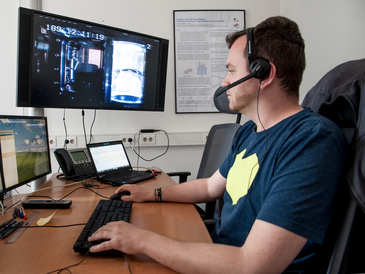Since 21st June 2013, scientists from the University of Bremen’s Center for Applied Space Technology and Microgravity (ZARM) have been able to resume experiments on board the International Space Station. Initially intended as a one-time experiment to measure the flow characteristics of liquids under zero gravity in 2011, the scientists have now succeeded in reactivating the experiment set-up for a second series of experiments. The team of scientists led by ZARMProf. Michael Dreyer is celebrating the event as a technological milestone.
When the offer came from NASA to make use of the experiment set-up for a second time, the scientists at ZARM could hardly believe their luck. A second run would enable them to obtain more valuable data without the time-consuming and enormously expensive financial cost of additional transport to the Space Station. The team has already chalked up a number of successes in the area of monitoring and control of experiments on board the ISS. This time, though, the task on hand presented an exceptional challenge. Working from the ground station in Bremen, they had to return the experiment set-up to a controllable and functioning state by means of telemetry. This involved installing a phase separation in a piece of experimental equipment called “Capillary Channel Flow (CCF)”, which monitors the behavior of two-phase flows (liquid and gas).
The possibility to use a camera from the Space Station’s standard equipment was a welcome bonus: This makes it possible to obtain even more accurate observations and evaluations. The American partner, Portland State University in Oregon, took care of instructing the astronauts on how to install the camera.
It took them a remarkably short time to reactivate the CCF experimental unit. On 15th June 2013, astronaut Chris Cassidy began installing the “Microgravity Glove Box”, the experimental chamber used for zero gravity experiments. Just a few days later, on 21st June 2013, the ground stations in Bremen and Portland initiated normal operation via telemetry and telecommand, enabling the experiment set-up to once again gather data. Among the significant gains brought about by this unexpected reuse of the experiment is the knowledge gained from the successful reactivation experience. This will come in useful when designing future two-phase experiment set-ups.
The experiment
The latest experiments confirm the results obtained in 2011, showing that the experimental equipment delivers reproducible conditions and results. On the one hand, this means that the planned series of experiments can be augmented with additional data points. On the other hand, the additional experiment time of four weeks makes it possible to include previously unexplored aspects – an enticing prospect for the ZARM researchers. “Extra science” is the name NASA uses for research opportunities that come up outside scheduled timetables. The promise of such additional results is the reason why NASA was so keen to push ahead with reactivating the experiment. Both the American as well as the German space agency hope to gain important knowledge for future expeditions into space.
INFOBOX:
The project is supported in international cooperation between NASA and DLR (aerospace management). Lead investigators are Prof.Dr. Mark Weislogel from Portland State University in Oregon, USA, and Prof.Dr. Michael Dreyer from ZARM, specialty fluid mechanics and multiphase flows.
ZARM website:
ZARM press release on CCF experiment 2011
http://www.zarm.uni-bremen.de/fluid-dynamics/multiphase-flow/projects/capillary-channel-flows.html?L=1
NASA website:
http://microgravity.grc.nasa.gov/SOPO/ICHO/IRP/MSG/CCF/
http://www.nasa.gov/mission_pages/station/research/experiments/303.html
Most recent publication:
Canfield, P. J., Bronowicki, P. M., Chen, Y., Kiewidt, L., Grah, A., Klatte, J., Jenson, R., Blackmore, W., Weislogel, M. M., Dreyer, M. E.: The capillary channel flow experiments on the International Space Station: experiment set-up and first results, Exp. Fluids 54 (1519), 1-14 (2013)
Contac t persons for further information:
t persons for further information:
Prof.Dr. Michael Dreyer
email: michael.dreyerprotect me ?!zarm.uni-bremenprotect me ?!.de
Phone: +49 421 218-57866
General press inquiries and requests for image materials:
BirgitKinkeldey
email: birgit.kinkeldeyprotect me ?!zarm.uni-bremenprotect me ?!.de
Phone: +49 421 218-57755

